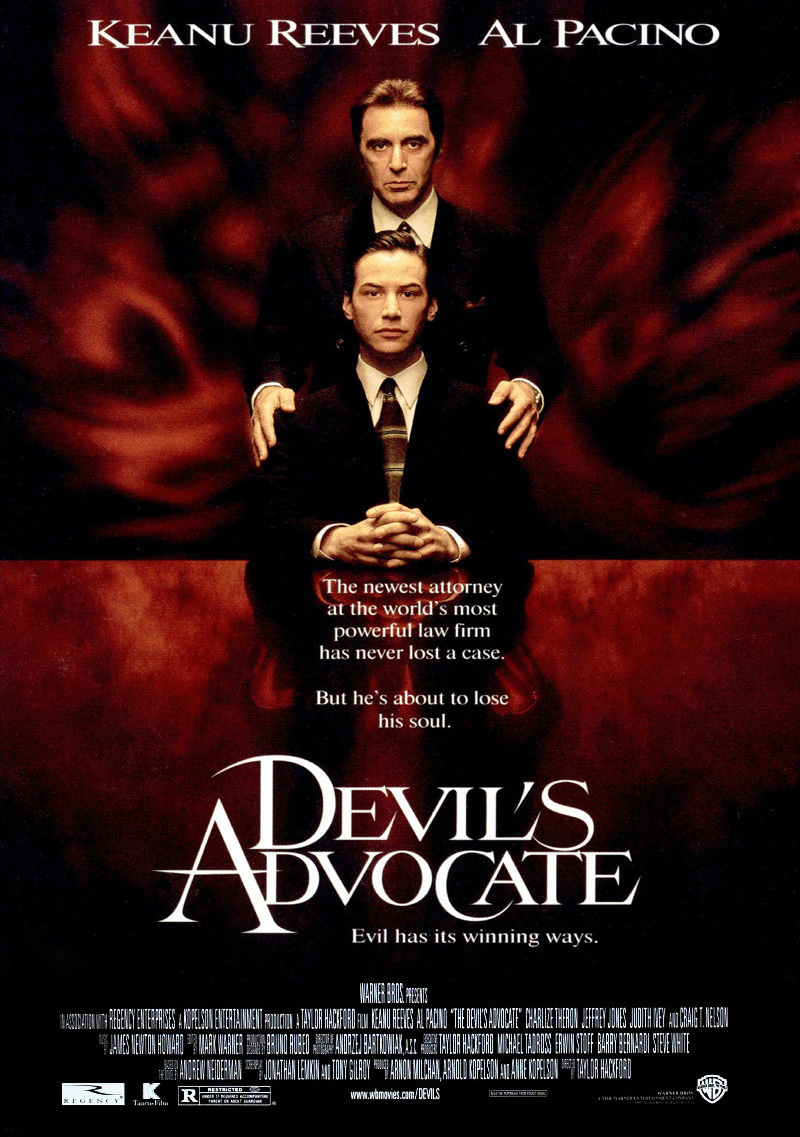“The Devil’s Advocate” (1997): A Faustian Tale in the Modern Legal Labyrinth – Film Review

Released in 1997, “The Devil’s Advocate” stands as a compelling examination of ambition, morality, and the human soul, all set against the backdrop of a high-stakes legal world. Directed by Taylor Hackford and featuring standout performances by Al Pacino, Keanu Reeves, and Charlize Theron, this film weaves together elements of horror, drama, and thriller genres to explore timeless themes through a contemporary lens.
Plot and Performances: A Dance with the Devil
At its core, “The Devil’s Advocate” is a modern retelling of the Faustian bargain. Keanu Reeves stars as Kevin Lomax, a hotshot Florida lawyer who has never lost a case. His talent catches the attention of John Milton (Al Pacino), the charismatic and mysterious head of a powerful New York law firm. As Kevin is drawn deeper into Milton’s world, he finds his morals compromised and his soul at risk. Charlize Theron delivers a heartrending performance as Mary Ann Lomax, Kevin’s wife, who becomes increasingly alienated and tormented by their new life in New York.
Pacino’s portrayal of the devilish Milton is both charming and menacing, a role that allows him to showcase his range and charisma. Reeves, meanwhile, convincingly portrays Lomax’s descent from confidence to despair, embodying the ethical dilemmas faced by his character. Theron’s role as the supportive wife turned victim is pivotal, highlighting the personal costs of ambition and success.
Thematic Depth: Ethical Ambiguity and Moral Decay
“The Devil’s Advocate” delves into the ethical ambiguity of the legal profession, questioning the very nature of justice and morality in a capitalist society. The film’s portrayal of a law firm as the devil’s playground is a metaphor for the broader moral compromises individuals and societies make in the pursuit of power and success. It challenges viewers to reflect on the price of ambition and the value of the soul in a material world.
Behind the Scenes: Crafting a World of Temptation
The production of “The Devil’s Advocate” involved significant challenges, particularly in creating visual effects that could bring the film’s supernatural elements to life without overshadowing its psychological and moral drama. The special effects, while subtle, play a crucial role in the film’s climax, revealing the true nature of Milton’s character and his infernal origins.
Filming locations in New York City added a layer of authenticity to the narrative, capturing the allure and menace of urban life. The choice of settings, from the luxurious but impersonal law firm offices to the Lomax’s increasingly nightmarish apartment, visually represents the characters’ internal journeys.
Music and Cinematography: Enhancing the Narrative
The film’s score, composed by James Newton Howard, underscores the tension and drama without overwhelming the narrative. Cinematographer Andrzej Bartkowiak uses light and shadow effectively to create an atmosphere that is both realistic and surreal, particularly in scenes that hint at the supernatural forces at play.
Cultural Impact and Legacy
“The Devil’s Advocate” was both a critical and commercial success upon its release, praised for its performances, especially Pacino’s, and its engaging exploration of moral themes. Over the years, it has maintained a cult following, appreciated for its intelligent script, compelling characters, and its ability to blend genre elements seamlessly.
The film raises questions that remain relevant, such as the nature of evil, the corruption of power, and the possibility of redemption. Its examination of the legal profession and the moral compromises individuals face in their careers and personal lives continues to resonate with audiences, making “The Devil’s Advocate” a thought-provoking piece of cinema that challenges viewers to consider their own values and choices.
Reflecting on the Faustian Bargain
In conclusion, “The Devil’s Advocate” is a richly layered film that offers more than just supernatural thrills. It is a profound commentary on ambition, ethics, and the human condition, anchored by strong performances and a thought-provoking narrative. Through its exploration of the seductive nature of power and the eternal struggle between good and evil, the film invites viewers to ponder the true cost of their desires and the meaning of success.




